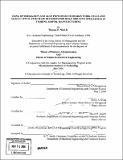| dc.contributor.advisor | Janice A. Klein and David H. Staelin. | en_US |
| dc.contributor.author | Neal, Thomas E. (Thomas Eugene) | en_US |
| dc.contributor.other | Leaders for Manufacturing Program. | en_US |
| dc.date.accessioned | 2007-07-18T13:13:10Z | |
| dc.date.available | 2007-07-18T13:13:10Z | |
| dc.date.copyright | 2006 | en_US |
| dc.date.issued | 2006 | en_US |
| dc.identifier.uri | http://hdl.handle.net/1721.1/37939 | |
| dc.description | Thesis (M.B.A.)--Massachusetts Institute of Technology, Sloan School of Management; and, (S.M.)--Massachusetts Institute of Technology, Dept. of Electrical Engineering and Computer Science; in conjunction with the Leaders for Manufacturing Program at MIT, 2006. | en_US |
| dc.description | Includes bibliographical references (p. 86). | en_US |
| dc.description.abstract | Classical manufacturing work cells have machines to perform each operation in the process, the number of each type of machine being chosen so that all machines would be equally busy. Although design of work cells for producing one product is straightforward, the design of a multi-product work cell is much more complex. Each product might require different machinery or require different processing times per operation, which complicates leveling the workload between machines. The decision of what type of machinery to purchase for a particular operation can be complex in itself when comparing a number of technologically different alternatives. Although the machines' operating characteristics might be well known, it is often difficult to understand how each technology will affect the overall production system. Any new work cell implementation is bound to cause friction within the organization. Change must be properly managed if it is to be done correctly. To implement any new structure for a work cell, both management and hourly employees must learn a new way of doing things. Often these new methods encounter significant resistance if not implemented in a way that takes into account their cultural impact. | en_US |
| dc.description.abstract | (cont.) This thesis describes a method for designing multi-product manufacturing work cells that utilizes optimization techniques to select capital machinery and uses Lean principles to assemble the machinery into an efficient and effective unit. It also shows how the best machinery for an operating environment can be chosen from two competing technologies. Finally, the thesis describes methodology for implementing new work cells in a change-adverse culture. Although this thesis applies to the manufacture of almost any product, its example involves a factory manufacturing turbine airfoils and, more specifically, the design of work cells for drilling holes in turbine airfoils. | en_US |
| dc.description.statementofresponsibility | by Thomas E. Neal, Jr. | en_US |
| dc.format.extent | 86 p. | en_US |
| dc.language.iso | eng | en_US |
| dc.publisher | Massachusetts Institute of Technology | en_US |
| dc.rights | M.I.T. theses are protected by copyright. They may be viewed from this source for any purpose, but reproduction or distribution in any format is prohibited without written permission. See provided URL for inquiries about permission. | en_US |
| dc.rights.uri | http://dspace.mit.edu/handle/1721.1/7582 | |
| dc.subject | Sloan School of Management. | en_US |
| dc.subject | Electrical Engineering and Computer Science. | en_US |
| dc.subject | Leaders for Manufacturing Program. | en_US |
| dc.title | Using optimization and lean principles to design work cells and make capital purchase decisions for hole drilling operations in turbine airfoil manufacturing | en_US |
| dc.type | Thesis | en_US |
| dc.description.degree | S.M. | en_US |
| dc.description.degree | M.B.A. | en_US |
| dc.contributor.department | Leaders for Manufacturing Program at MIT | en_US |
| dc.contributor.department | Massachusetts Institute of Technology. Department of Electrical Engineering and Computer Science | |
| dc.contributor.department | Sloan School of Management | |
| dc.identifier.oclc | 144555003 | en_US |
